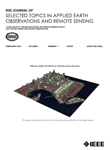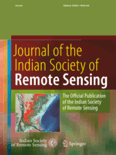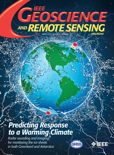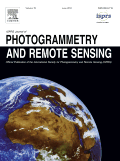
Science of Remote Sensing
metrics 2024
Unlocking the Potential of Remote Sensing Technologies
Introduction
Science of Remote Sensing, published by Elsevier, is a premier open-access journal that has been at the forefront of interdisciplinary research since its inception in 2020. With an impressive impact factor and its status in the Q1 quartile category for both Earth and Planetary Sciences and Forestry, this journal effectively caters to a diverse audience, including researchers, professionals, and students interested in the latest developments in remote sensing technologies and their application across varied domains. Located in the Netherlands, the journal provides a collaborative platform for scientific discourse, ensuring that impactful research is easily accessible to the global community. As it converges its focus through to 2024, Science of Remote Sensing continues to promote innovation and excellence, establishing itself as a vital resource for advancing knowledge in both the agricultural and environmental sectors. With a robust ranking (Rank #6 in Forestry and Rank #8 in General Earth and Planetary Sciences), it is well-positioned to contribute significantly to ongoing scientific advancements.
Metrics 2024
 2.37
2.37 5.70
5.70 7.80
7.80 15
15Metrics History
Rank 2024
Scopus
IF (Web Of Science)
JCI (Web Of Science)
Quartile History
Similar Journals

IEEE Journal of Selected Topics in Applied Earth Observations and Remote Sensing
Exploring the Frontiers of Applied Earth Observations.IEEE Journal of Selected Topics in Applied Earth Observations and Remote Sensing is a premier peer-reviewed journal published by the IEEE-INST ELECTRICAL ELECTRONICS ENGINEERS INC, focused on advancing the field of Earth observation and remote sensing technologies. With an impressive impact factor, this journal ranks in the top quartile (Q1) for both Atmospheric Science and Computers in Earth Sciences, underscoring its significance and influence in the academic community. Open access since 2020, it facilitates broader dissemination of research findings to enhance global visibility and accessibility for researchers, professionals, and students alike. Spanning the years from 2008 to 2024, the journal covers a myriad of topics that highlight innovative applications of remote sensing data and technologies in addressing environmental challenges. With a Scopus ranking placing it in the 91st and 89th percentiles, respectively, in its categories, the journal serves as a vital resource for advancing scholarly discourse and collaboration in Earth sciences.

Journal of the Indian Society of Remote Sensing
Connecting Scholars to the Frontiers of Remote SensingJournal of the Indian Society of Remote Sensing, published by SPRINGER, stands as a prominent contribution to the fields of Earth and Planetary Sciences and Geography, Planning and Development. With an ISSN of 0255-660X and an E-ISSN of 0974-3006, this esteemed journal has been in circulation since 1973, showcasing a rich repository of research and advancements in remote sensing applications, methodologies, and technologies, specifically within the Indian context and beyond. The journal's impact is underscored by its placement in the Q2 category of both Earth and Planetary Sciences and Geography as of 2023, ranking impressively in the Scopus database with significant percentiles. With the intent to bridge the gap between theory and practical application, it invites scholars, researchers, and professionals to contribute innovative studies that enhance our understanding of remote sensing and its implications in various domains. The Journal of the Indian Society of Remote Sensing is a vital resource for anyone looking to remain at the forefront of research in this dynamic field.

Journal of Geovisualization and Spatial Analysis
Charting New Territories in Spatial AnalysisJournal of Geovisualization and Spatial Analysis, published by SpringerNature, is an influential open-access journal specializing in the cutting-edge fields of geovisualization, spatial analysis, and their application in earth sciences and geography. Since its inception in 2017, this journal has established a prominent stance with a high impact factor and prestigious Q1 rankings across multiple categories, including Computers in Earth Sciences, Earth and Planetary Sciences (miscellaneous), and Geography, Planning and Development. The editorial board is committed to advancing innovative research and methodologies, providing a platform for scholars to disseminate their findings globally. With impressive Scopus rankings—placing it in the top percentiles among its peers—the journal serves as a vital resource for researchers, professionals, and students keen on understanding spatial data and its implications for geographic science. Its emphasis on rigorous peer review and rapid publication enhances accessibility to substantive research, thus fostering knowledge sharing within the scientific community. Based in Switzerland, the journal promotes a collaborative environment for interdisciplinary studies, making it an essential read for anyone involved in spatial analysis research.

IEEE Geoscience and Remote Sensing Magazine
Advancing Knowledge Through Innovative ResearchIEEE Geoscience and Remote Sensing Magazine, published by the esteemed IEEE-Institute of Electrical and Electronics Engineers Inc, serves as a pivotal platform for cutting-edge research in the realms of geoscience, remote sensing, and related disciplines. With an ISSN of 2473-2397 and E-ISSN of 2168-6831, this prestigious magazine has established itself as a leading resource in its field, achieving a Q1 ranking across multiple categories including Computer Science, Earth and Planetary Sciences, and Electrical and Electronic Engineering. Researchers will appreciate its high impact, recognized by impressive Scopus rankings—2nd in Physics and Astronomy, 3rd in Earth Sciences, and 7th in General Computer Science, placing it firmly in the top percentiles globally. Published bimonthly and compatible with various access options, the magazine aims to disseminate innovative solutions and technological advancements, fostering collaboration and knowledge-sharing among professionals, students, and industry stakeholders. As it converges its contributions from 2013 to 2024, IEEE Geoscience and Remote Sensing Magazine continues to significantly influence the scientific community's understanding of the planet and its systems.

Remote Sensing in Ecology and Conservation
Transforming ecological understanding with open-access discoveries.Remote Sensing in Ecology and Conservation is a pioneering journal published by WILEY that has been a beacon of open-access research since 2015. With an E-ISSN of 2056-3485, this journal stands at the forefront of the intersection between ecological research and technological innovation. It is recognized for its significant impact, boasting Q1 rankings across several prestigious categories in 2023, including Computers in Earth Sciences and Ecology, emphasizing its commitment to high-quality, influential scholarship. The journal provides a platform for researchers and practitioners to share their findings in remote sensing applications that advance ecological conservation efforts. Encompassing a broad scope that includes studies on landscape changes, biodiversity assessments, and environmental monitoring, it serves as an essential resource for education and practice in the field. With impressive ranks in Scopus, including a remarkable 6th place in Earth and Planetary Sciences, it continues to shape the dialogue in ecology and conservation. As an open-access journal, it champions the dissemination of knowledge, making critical research accessible to a global audience, thereby fostering innovation and collaboration in the pursuit of sustainable environmental practices.

Geographia Technica
Bridging Disciplines for a Sustainable FutureGeographia Technica is an esteemed academic journal published by GEOGRAPHIA TECHNICA ASSOCIATION - GT Assoc in Romania, serving as a vital platform for the dissemination of cutting-edge research in the interdisciplinary fields of geography, planning, and earth sciences. Since its inception in 2009 and continuing through to 2024, the journal has established itself as a respected source of knowledge, reflected in its classification within the Q3 category across significant fields such as Computers in Earth Sciences, Earth-Surface Processes, and Geography, Planning and Development. With the ambition to enhance the understanding of socio-environmental interactions and technological applications in these areas, Geographia Technica invites scholars and practitioners to contribute original research that pushes the boundaries of current knowledge. Although currently not listed as open access, the journal's engaging content ensures it remains a valuable resource for researchers, professionals, and students keen on advancing their expertise in these dynamic disciplines.

European Journal of Remote Sensing
Unlocking Insights Through Innovative Earth ObservationThe European Journal of Remote Sensing, published by Taylor & Francis Ltd, stands as a pivotal resource in the domains of applied mathematics, atmospheric science, and earth sciences. Since its transition to Open Access in 2012, the journal has facilitated unrestricted knowledge dissemination, fostering collaboration and innovation among researchers. With a notable impact factor reflected in its quartile rankings—achieving Q2 in applied mathematics and atmospheric science, and Q1 in miscellaneous environmental science—the journal is a respected platform for high-quality research. Based in the United Kingdom, it encompasses a wide range of topics related to remote sensing technologies and their application in environmental monitoring. Researchers and professionals in these fields will find the journal indispensable for its commitment to advancing scientific understanding and promoting the use of remote sensing methodologies in tackling contemporary environmental challenges.

International Journal of Image and Data Fusion
Integrating Knowledge for a Brighter Scientific FutureThe International Journal of Image and Data Fusion, published by TAYLOR & FRANCIS LTD, is a premier scholarly journal dedicated to the fields of computer science applications and earth and planetary sciences. With an ISSN of 1947-9832 and E-ISSN 1947-9824, this journal offers a unique platform for researchers, professionals, and students interested in the innovative integration of image processing and data fusion techniques. Operating from the United Kingdom, it plays a vital role in advancing knowledge and facilitating discussions in these rapidly developing domains, evidenced by its ranking within the Q3 category for Computer Science Applications and Q2 for Earth and Planetary Sciences in 2023. The journal features rigorous peer-reviewed content that spans from 2010 to 2024, encouraging the dissemination of novel research findings and methodologies. With a notable impact factor and strong Scopus rankings, it remains an essential resource for those seeking to enhance their understanding and application of sophisticated data fusion technologies in their academic or professional work.

ISPRS JOURNAL OF PHOTOGRAMMETRY AND REMOTE SENSING
Delivering Premier Research for a Global AudienceISPRS Journal of Photogrammetry and Remote Sensing is a prestigious publication at the forefront of the fields of photogrammetry and remote sensing. Established in 1989 and published by Elsevier, this journal has consistently maintained a strong academic standing, currently holding a top-tier Q1 ranking across multiple categories, including Atomic and Molecular Physics, Computer Science Applications, and Engineering. This reflects its vital contribution to advancing knowledge and technology in these dynamic fields. The journal is not only a vital resource for researchers and professionals but also serves as an essential academic platform for students keen on delving into the latest developments in geospatial sciences. The journal operates under a non-open access model, ensuring that submitted research adheres to the highest standards of scholarly communication and integrity. With an impactful focus, it brings innovative research, comprehensive reviews, and significant case studies to a global audience. The ISPRS Journal is crucial for those aiming to enhance their understanding and application of remote sensing techniques within various scientific disciplines.

Applied Geomatics
Harnessing the power of geomatics for global impact.Applied Geomatics is an esteemed academic journal published by SPRINGER HEIDELBERG, dedicated to advancing the field of geomatics through rigorous research and innovative applications. With an ISSN of 1866-9298 and an E-ISSN of 1866-928X, this journal has gained a prominent standing in multiple disciplines, achieving a Q2 ranking in esteemed categories such as Earth and Planetary Sciences, Engineering, Environmental Science, and Geography. The journal's convergence of research from 2009 to 2024 positions it as a vital resource for both scholars and practitioners seeking to understand and leverage geomatic technologies in real-world scenarios. Located in Germany, Applied Geomatics not only contributes to theoretical advancements but also to practical methodologies that address current environmental challenges. Its accessibility and relevance ensure that the findings discussed within its pages are pivotal for professionals, researchers, and students alike, fostering collaboration and innovation within the field.